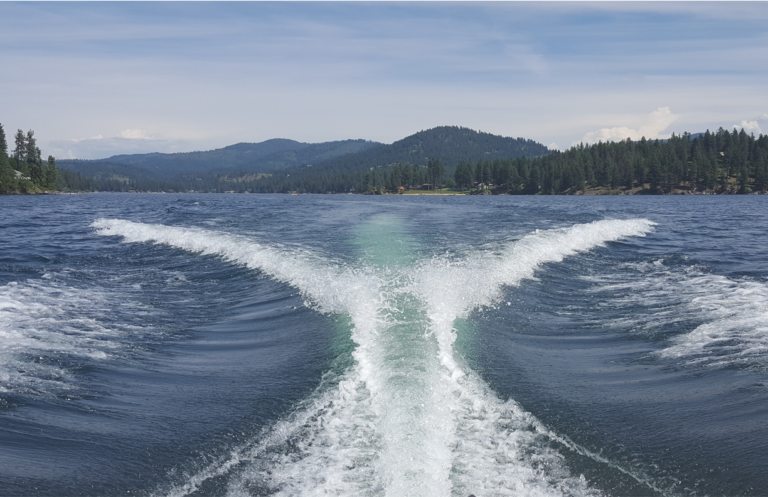The following is a message from Steve Meyer, the Chairman of the Hayden Lake Watershed Improvement District’s Board of Directors.
We hear rising concern about bank erosion and weed spread from wakes. Shoreline erosion adds phosphorous to the lake, and invasive weeds propagate around the shoreline. Wake boats (sometimes called ballast boats) create 3’ + wakes. These take a very long distance to dissipate and can damage docks and shorelines. It is very difficult to enforce the 200’ no wake zone because there are no reliable reference points, i.e., no-wake buoys at the 200’ mark.
The upcoming Annual Meeting of the Hayden Lake Watershed Association Inc. will have a report on water quality and a panel discussion about invasive weeds and no-wake buoys. Early conversation begins at 6:00 at the Hayden Lake Country Club; the meeting opens at 6:30.
The Improvement District web page is a good source for weed management information.
Here is an update on the buoy planning going on:
- There is general agreement that the most effective way to get boater compliance with the 200’ no wake zone is through County Sheriff enforcement.
- Consistent placement of buoys at 200’ is needed for both boaters’ and Sheriff’s visual reference. Currently, buoys are not consistently placed, and the Sheriff cannot enforce the regulation.
- We don’t want a picket fence of buoys circling the lake.
- The Idaho Department of Lands (IDL) has regulatory authority over encroachments into the lake including docks and buoys. Only those permitted by IDL are legal.
- Currently, a few legal buoys mark the western shoreline with permits issued mostly to the City of Hayden Lake.
- About 40 illegal buoys have been placed around the lake, by property owners, at varying distances from the shore.
- IDL plans to require removal of the illegal buoys.
- The County and the Watershed Improvement District have an agreement for the Improvement District to pay for placement of legally-permitted buoys.
- County Parks and Waterways applied for 14 buoy permits, and we understand that IDL intends to issue them.
- The preliminary plan has been to place 8 of the 14 buoys in high-trafic locations.
- We have 40+ miles of shoreline. How many buoys are appropriate?
- One idea is to place buoys within line-of-sight of each other, visible in the daylight and illuminated by blinking lights at night. These will provide all boaters with clear reference points.
- The Sheriff’s Marine Department will determine the exact location of buoys.
- We can give input to the Marine Department relevant to the number and locations needed.
The meeting this Thursday night is one of the few times when we all get together. Please come with your ideas.
I hope you can attend.
Steve Meyer
Chairman
Hayden Lake Watershed Improvement District



2 Responses
The most recent monitoring results from Hayden Lake will be discussed at the annual meeting. The Watershed Improvement District has been monitoring the lake’s North Arm including the area near Sportsmans Access for several years. This part of the lake is not phosphorous limited due to the high total and ortho-phosphate concentrations in the water, rather it is nitrogen limited. When nitrogen chemical species becomes low in a low runoff year, blue-green algae (cyanobacteria) are able to grow without competition because, unlike their competitors green algae and diatoms, the blue-green algae are capable of fixing atmospheric nitrogen. The District monitoring seeks to forecast the depletion of the nitrogen chemical species used by the green algae and diatoms in order to predict the situation that will cause a blue-green algae bloom. Ironically, we have not seen such conditions for the past two years. Last year featured a robust runoff and just as nitrogen compounds were nearing depletion, treatment of the invasive aquatic weed by the Idaho Department of Agriculture (IDA) killed the weeds and freed up nitrogen compounds necessary to maintain the algal species balance. This year, runoff was somewhat less, however, early treatment of curly-leaf pondweed by IDA released nitrogen compounds as well. The District will continue to measure water quality in the lake including the North Arm until late September this year. A consultant and myself, both water quality professionals, review the data on a regular basis as it comes in.
We are year-round residents (since 2014, . . . retired here from Idaho Falls, ID) at the north “tip” of the lake (west of Sportsman’s access). We are very concerned about the annual toxic blue green algae that invades our bay each year, creating unreasonable risk for our dog and grandchildren to be in the water. Will the toxic algae blooms be discussed at the meeting tomorrow? We hope that the residents can more readily and immediately be informed when toxic blooms occur (as opposed to having to constantly monitor DEQ/etc websites). Additionally, we are interested in knowing what can/is being done to address this annual concern (and how does the weed treatment effect future blooms?). Thanks! (we will be at the meeting tomorrow!)
Comments are closed.